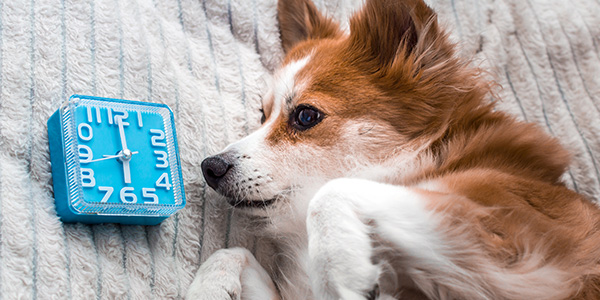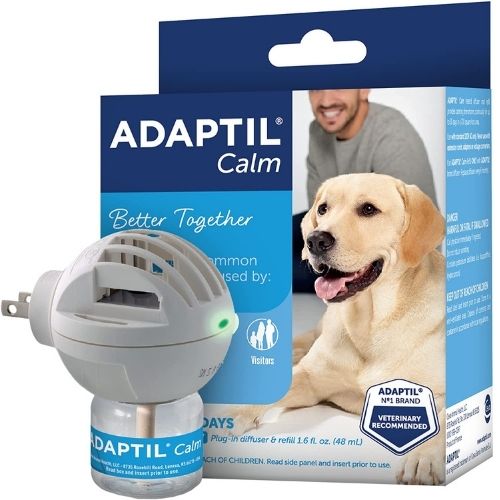 You might have heard that keeping your dog on a daily routine helps with behavior and training — which is true in some cases.
You might have heard that keeping your dog on a daily routine helps with behavior and training — which is true in some cases.
But sometimes a strict adherence to a routine creates anxiety issues in your pup when all of a sudden they have a day where the routine gets thrown out the window.
Lots of unplanned events can pop up and you don't want your dog to become stressed if they don't get their walk at the normal time, or you won't arrive home until later than usual.
Dogs that suffer from separation anxiety or isolation distress, they are extremely aware of routine events that predict your leaving, which triggers their anxiety. When working on separation anxiety with your certified dog trainer or board-certified veterinary behaviorist, modifying your pre-departure routines might be one of the first steps of treatment.
So when is a routine helpful versus a hindrance? Let's look at different reasons a routine might be a good choice for you and your dog, versus when you might want to mix it up.
When Routines are Useful: Puppies and New Dogs
Dogs do well when they know what to expect from their environment, especially when it comes to safety and access to food. When you first bring home a new dog, whether a young puppy or an adopted dog, creating a routine can help them settle in during their adjustment period. They'll learn that they have access to water and consistent meals, regular exercise, mental enrichment, and that they have a safe place to be in their new home.
Routine is also key to potty training success. You want to give them consistent outdoor potty opportunities, especially right after they wake up and after eating meals. You'll be able to anticipate when they'll most likely need to eliminate if they're on a regular feeding schedule, which helps you prevent indoor potty accidents (download this Puppy Potty Log for an easy way to track your pup's elimination schedule).
However, as your new dog acclimates to their new home and as your puppy grows older, you want to avoid creating such a strict schedule that they don't know how to handle being left alone for longer than usual, a late feeding time, or missing their usual morning walk.
 A Daily Structure is More Important than a Strict Routine for Your Dog
A Daily Structure is More Important than a Strict Routine for Your Dog
As your dog gets more comfortable in their new home, it's useful to mix up their routine every so often to prevent separation anxiety, and lessens both your and your dog's stress in case you can't make it home in time for a regular feeding or walk.
This is where a structure is more important than sticking to a strict routine. You want your dog to learn that they will be fed, but it might not always be at 7:00 am on the dot. Your dog needs structure in that you always return home, but not become anxious if you don't walk in the door at exactly 5:30 pm.
For example, my dog Sookie has a structured day in that she is taken outside once we wake up, which is not at the same time every morning (I do like to get a couple of extra hours of sleep on the weekend). Some days she gets a long walk in the morning and other days it's just a mini-walk before we go to work together.
While Sookie comes with me to work most of the time, some days I take her to dog daycare or leave her at home. If she didn't get a longer walk in the morning, that means she'll get one in the evening or we'll play with the flirt pole after work to burn some energy. I mix up her walks with playing fetch, tug, or a play date with a friend. She's fed breakfast and dinner around the same time each day, but she doesn't come to bug me at a certain time if her bowl is still empty. This means I have greater freedom to have a varied daily schedule and Sookie is able to cope with any unexpected changes.
One occasion of a daily routine backfiring was with another Preventive Vet team member's Mini-Goldendoodle puppy, Mary Berry. Before joining our team, Mary Berry's owner Marissa worked regularly from home, and Mary Berry was used to that routine. Once Marissa changed to working away from home, Mary Berry had a tough time transitioning to being left at home without constant attention and company.
Read more about how Marissa helped Mary Berry adjust to her new work schedule in the article "Preventing Separation Anxiety When You Work From Home."
How to Introduce a Change in Routine to Your Dog
When you're transitioning from a stricter routine to a structured day with your dog, you'll want to watch for any signs of stress or anxiety. To help prevent this, make small, incremental changes to their daily routine. Choose just one thing in the schedule to modify at a time — such as arriving home in the evening 5 to 10 minutes later than usual, but keeping feeding and regular exercise routines the same. Watch for signs of stress or anxiety and adjust the routine accordingly.
You can use calming pheromones or other calming supplements to help your dog better cope with a change in their routine. Adaptil offers dog appeasing pheromones in three easy options: Calm On-The-Go Collar, Plug-in Diffuser, or their Calming Travel Spray.
There are various calming supplements on the market, and two of our favorites are Solliquin Soft Chews and Composure Chews. Once your dog has gotten used to the change, you can wean them off the calming spray or supplements.
Once your dog is used to a varied schedule of your returning home, then start to slowly adjust other parts of their routine. If you notice that your dog is exhibiting anxiety or a particular behavior change when you start to mix up their routine, it's best to connect with a certified dog trainer in your area who can help you build up your dog's coping skills and prevent separation anxiety or isolation distress.
A Note About Dog Training Routines
You've probably heard the advice that keeping a routine is important when training your dog — but one thing to remember is your dog is always learning. Consistency in communicating your training expectations for your dog is more important than training at the same time and for the same length of time each day.
It's usually easier for most dog owners to practice short training sessions multiple times throughout the day, rather than trying to set aside an hour every day to practice training. Your dog will also learn faster and better with varied training times. Try to take advantage of daily training opportunities as they happen. For example, if you're working on sit and stay at the door, practice this every time you're going through the door with your dog! Not just during planned training sessions.
With time your dog will feel safe and secure with a structured day, and won't get anxious if their schedule is a bit different day-to-day.
Have questions about how to adjust your dog's routine or want to share your experience?
Let us know in the comments below!





